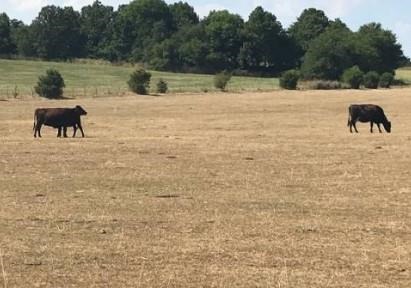Most of Missouri is experiencing drought conditions, which have extended almost a full year, putting enormous pressure on cattle producers. University of Missouri Extension specialists have five top action items for producers to do now:

Christian County pasture affected by drought. Photo by Tim Schnakenberg.
1. Cull herd(opens in new window). Candidates include open females, cattle with health issues and poor dispositions and females bred outside of preferred calving windows. Wean calves early(opens in new window) to give flexibility; sell if water and feed are too expensive for pound of gain.
2. Find alternative feeds(opens in new window). Monitor costs of byproduct feed and compare costs to purchased hay and other feed. Energy typically is more limiting than protein.
3. Check toxicity of alternative feedstuffs(opens in new window). Using drought-stunted/stressed crops and summer annual forages, as well as grazing areas and purchased hay of marginal quality, can expose cattle to toxic forages. Know your risks and consult with your veterinarian.
4. Prepare for the fall. Develop your fall forage plan now. Inventory pastures and consider options for the fall based on their condition; overseed winter annuals, apply nitrogen fertilizer, initiate pasture renovation. Be ready to start in August. For more information, consider attending a Missouri Grazing School(opens in new window), taught by MU Extension and the USDA Natural Resources Conservation Service.
5. Stretch current feed supplies(opens in new window). Improve grazing management and reduce hay waste(opens in new window). Sort cows by those that are nursing and not nursing, then feed to their nutrient requirements.
Source : missouri.edu